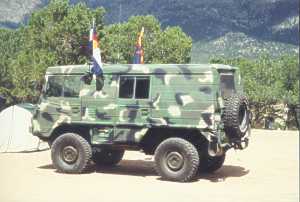Brief by Central Staff
Transportation – September 2002 – Colorado Central Magazine
If you live in Salida, you’ve likely seen one of these rare vehicles parked on F Street in front of Real American Actionware, which uses them for some deliveries. If you were around Buena Vista on the weekend of July 25-28, you might well have seen a whole caravan of them: boxy high-clearance four-wheel-drive vehicles known as Pinzgauers.

The offbeat vehicles, along with their small cousins known as Haflingers, were gathered at the Crazy Horse Campground north of Buena Vista for the Rocky Mountain Pinzgauer Club’s third annual “treffen” – German for “meeting” or “rally.” The two previous treffens were in Leadville and Breckenridge.
What’s a Pinzgauer? Well, there’s the famous Swiss Army knife, and the Pinzgauer is the Swiss Army truck. It has 14 ½ inches of ground clearance and a 95-hp 4-cylinder air-cooled engine, with a five-speed manual transmission that works with two-speed transfer case, and a locking differential on front and back axles. It can carry up to 3,000 pounds, turn about as tightly as a motorcycle, handle a 45-degree side slope without rolling, and climb any grade that its tires can grip. Its ride is surprisingly smooth, but don’t plan on conversing during a trip unless you’ve got a bullhorn, and you’d need a stiff tailwind and a downhill grade to get more than 18 miles per gallon.
The Pinzgauer is made in Austria, and is used by many armies, not just the Swiss. But you won’t see any new ones in the United States. It doesn’t meet certain import specifications set by the U.S. Department of Transportation; however, those rules don’t apply if the vehicle is more than 25 years old.
“So as armies replace their vehicles, we get the old ones,” explained Patrick Robb, who imports and sells them through his company, Cold War Remarketing of Littleton (www.coldwarremarketing.com). “For instance, the Swiss Army is going to all diesel-fueled vehicles, so they’re selling off their old gasoline-powered equipment.”
As the military-surplus 1977 Pinzgauers arrive at the docks, Robb (along with less than a dozen other U.S. dealers) refurbishes them, and perhaps 150 of them go onto America’s highways and back roads each year. He estimates that of the 220 million motor vehicles registered in the United States, about 3,000 are Pinzgauers – of which 75 were in Buena Vista for the 2002 Treffen.
New Pinzgauers cost about $100,000 from somebody’s tax money. Used ones are “in the $10,000 range,” Robb said, “so they’re priced competitively with other 4WD rigs.” That’s for the pipe-rack military model; some folks at the Treffen had obviously lavished a lot of expensive affection on their Pinzgauers.
What happens at a Treffen is pretty much what happens when any group of fans gathers for a few days. They hold a couple of picnics, and swap stories and parts. They also tested their rigs on some nearby back-road excursions, ranging from relatively easy Tincup Pass to challenges like Baldwin Gulch and China Peak.
“So far, nobody’s gotten stuck or broken down,” Robb said. Foreign vehicles have a reputation for being hard to fix, but Robb says that Pinzgauers are different. “These things are built to be repaired by teenagers in the field who are getting shot at. That makes it pretty easy to keep one running.”
Of course, he’s a used-car salesman. And, as I discovered when I checked his website, he’s also a used-tank salesman, so I’m not going to be the one to argue with him. And besides, his previous customers all appeared to be enjoying their Pinzgauers as they prowled around some of the worst roads in the highest range in the Rocky Mountains.

